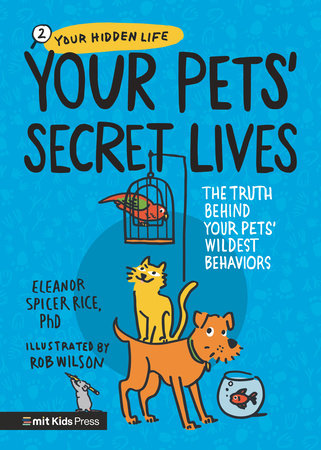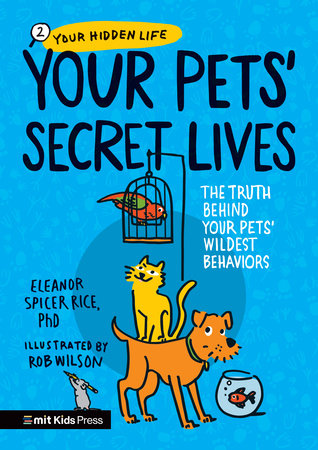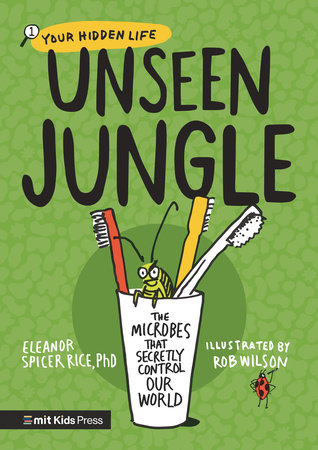Excerpt
Your Pets' Secret Lives: The Truth Behind Your Pets' Wildest Behaviors
Introduction More than half of us live with at least one creature that is not a human. Though they may have scales, fins, fur, or feathers, we consider them family members. Sometimes they might even seem like humans. Many greet us when we come home; some give us kisses or try to make us feel better when we’re blue. But trust us: our pets see the world in a totally different way than we do.
Our lovable housemates have superpowers that come from their ancestors’ wilderness survival skills. Some battle ancient foes, if only in their minds. Others can change color or shape. Still others have conversations that we can’t see or even hear.
These behaviors seem mysterious, but if you pay attention and know what to look for, you will begin to understand your pet in a whole new way. In these pages, we unlock some of our pets’ strangest behaviors. We shake their family trees, peek between their feathers, dive into their brains, and sometimes hitch a ride on their poops to uncover their hidden lives and reveal them to you.
What you do with these discoveries is up to you. Will you give your cat kisses with your eyeballs? Listen to your mouse’s roars? Comfort your tarantula when she has nightmares? Congratulate your dog on a well-aimed pee? Give your goldfish some happy memories to last a lifetime?
You know your pets better than anyone. And soon, after reading about their secret worlds, you may be able to understand them, too.
Part IDogs
Of course, you and your pup are best buds! You do everything together! Well, almost everything. There are some things a dog just needs to do on its own. Like poop in the most spectacularly secret way. And send you tail-wag flag signals. And . . . turn the page to find out!
Talk to the Tail
Sometimes we say it best when we say nothing at all. With that in mind, here’s a short list of some of the many everyday ways we talk with our hands instead of our mouths:
Wave:
Hello. Shrug:
I don’t know! Raised hand:
Hooray! or
I’m over here! Punch fist:
You dirty rascal!
or
I’m gonna beat you up! Shrug:
I’m not really
feeling it. Power fist:
We are the champions, my friend. Prayer hands:
Bless
your little pea-pickin’ heart. or
Thank you. Peace sign:
Peace out, homeslice! There are plenty more, of course. Some you’re probably not allowed to do. Don’t do those!
Dogs can talk without talking, too. Their paws don’t allow for much in the way of a thumbs-up, so they let their tails do the talking instead. Are you listening to those wags? If you are, you can learn more than just who’s a happy pup.
Here is a short list of everyday posterior postures to help you decode the tail talk.
Tail up:
Hello! You have
my attention! Circle wag:
You are my very favorite of all the favorites, and I am so happy to see you in the most wonderful of ways! Wag to left:
You make me nervous, and I’m not super sure about you. Wag to right:
I want to make you my buddy. or
I’m very happy to see you, buddy! Tucked tail:
Yikes! Also tucked tail:
Come and get me, sucker! Yes, a dog’s tail can be a window into its sunny little soul. Some tail positions are practical. Tucking that tail in, for example, makes it harder for anyone to nab Buster, whether he’s skittering off in play or worried someone’s going to bite him. A perky, upright tail can leave the back door open for a good old-fashioned butt sniff.
Scientists think dogs’ brain wiring leads to other tail positions. In dogs (and other animals, like humans—like YOU!), each side of the brain specializes in a different set of skills and feelings. The right side of the brain controls the left side of the body and links to using energy (run away!). It also links to feeling sad or afraid. The left side of the brain controls the right side of the body and links to feel-good, happy, calm-type feelings.
When a dog like Buster sees another dog wagging its tail to the left, Buster’s heart starts pounding. He acts anxious. Even without knowing everything the scientists know, Buster somehow associates that other dog’s left wag with the feeling that something is a little iffy about the situation.
On the other hand, when Buster sees another dog wagging its tail to the right, his heart rate stays nice and easy. He feels free to wiggle-waggle on up to that dog. With that right-tail-wag signal, Buster feels glad to see an old Buster buddy, or hopeful to make a new one.
Keep your eyes peeled for the silent signals from your best friend’s rear end. Is your buddy ready for fun? Or needing comfort? Now that you can catch the meaning of the wag, you’ll know for sure.






